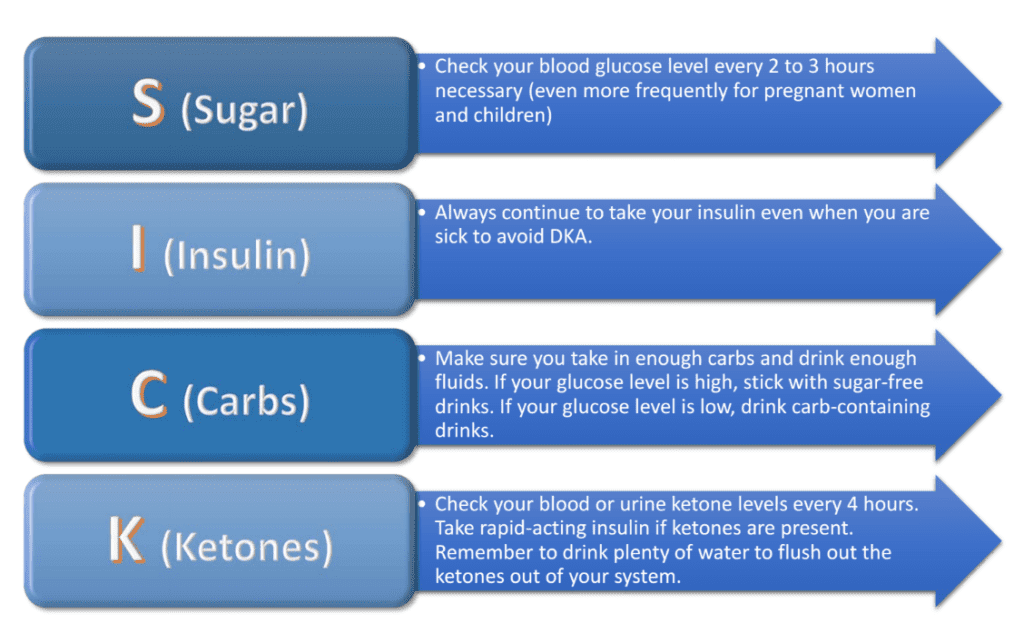
Image source: https://www.thediabetescouncil.com/wp-content/uploads/2016/06/diabetes-sick-day-management-tips-tricks-1024x643.png
What is diabetes?
1. Diabetes is a chronic disorder that occurs either when the pancreas does not produce enough insulin needed to process the glucose or when the body cannot effectively utilize the already produced insulin.
2. Insulin is a hormone (produced in the beta cells of Islets of Langerhans in the pancreas) responsible for regulation of blood sugar. Hyperglycaemia, or raised blood sugar, is a common effect of uncontrolled diabetes and over time leads to serious damage to many of the body's systems, especially the nerves and blood vessels.
3. Diabetes is of two types:
(i)Type-1/ insulin-dependent diabetes/ juvenile onset diabetes
(ii) Type-2/ noninsulin - dependent diabetes mellitus/ adult-onset diabetes
4. Type - 1: It occurs due to the body's inability to produce insulin (the vital hormone responsible for utilization of glucose and its conversion to energy) as a result of the autoimmune destruction of beta cells of the islets of Langerhans in the pancreas. It often begins in childhood, hence known as juvenile. However, this disease can also develop in the late 30's and early 40's. Juvenile diabetes can be hereditary or a cause of an autoimmune disorder.
5. Type - 2: It is a metabolic disorder characterised by hyperglycemia, (high levels of glucose circulating in the blood) which is a result of insulin resistance/ low production of insulin in the body (cells, fats, and liver do not respond to insulin; thus excess glucose does not get stored in the cells). Increasing inactivity and excessive consumption of junk food have made type-2 diabetes very common at every age.
6. Typical symptoms of Diabetes are Polydipsia (increased thirst), Polyuria (frequent urination), Polyphagia (increased hunger), unexplained and sudden loss of weight, blurring of vision, fatigue and nausea.
How to confirm if you have diabetes?
If one experiences any of the symptoms listed above, a simple blood test for glucose levels can detect the presence of diabetes. If the amount of glucose present in the blood is more than the clinically indicated values, then the test is considered as positive.
Is there a cure?
- A permanent cure for Diabetes Mellitus type-1 is not known. The most common approach for type-1 is insulin therapy. Diet, exercise, and self-monitoring of blood glucose levels can make living with the disease easier.
- Type-2 is treated by primarily controlling the dietary intake and exercises. However, if blood sugar levels are not in control, common medications like metformin and insulin therapy are recommended.
How to manage blood glucose levels?
- Whether you are prescribed oral medications or insulin injections, in the both the cases, you need you keep the sugar levels stable. This involves having five to six small meals (preferably fresh and rich in fibre) to maintain constant glucose levels.
- If you have diabetes, there is no compromise on exercise now. Not only does exercise boost your metabolism but also helps in weight management. Pilates, yoga or cardio, go ahead and keep yourself fit to fight diabetes.
- Irrespective of the type of diabetes you have, the first thing is to keep your glucose levels in check. Self-monitoring aids are of great help if you want to test the glucose levels immediately. Try Caresens blood glucose test strips. These strips are designed for easy use and require only a small sample of blood. No coding required for the test strips and an easy to read display screen helps you find out the glucose levels.
- Foot health is vital with diabetes. Diabetes can reduce the blood supply to your feet and cause a loss of feeling known as peripheral neuropathy. Wash your feet and keep a check for cuts or bruises. If you travel regularly, prefer a footwear which is protective in design.